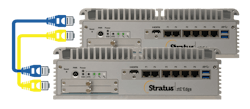Edge Computing for Packaging Machinery OEMs and End Users
Showcasing its ztC Edge Class 1, Div 2 industrial edge computing platform with built-in redundancy and security, Stratus Technologies shared a number of insights into edge computing use for end users and OEMs at PACK EXPO Connects.
The demo featured by Stratus in its exhibit showed how the zTC Edge can combine edge device monitoring and control software with multiple applications like HMI/SCADA, historians, PLC programming, and manufacturing execution systems on a single edge device using pre-configured virtual machines (VMs). This capability simplifies machine design by eliminating the need to install multiple computers to handle the various tasks. And by installing thin clients in a VM, the edge device allows operators to run machines remotely using cellphones, tablets, and laptops. This is a key factor in enabling the delivery of real-time machine data to enterprise systems and to the cloud for analysis.
With PACK EXPO Connects’ OEM audience in mind, Stratus showcased its top tips for packaging machinery builders who are exploring or expanding their use of edge computing technologies. Aric Prost, global leader, OEM at Stratus, outlined these edge computing assessment tips for OEMs, all of which are features of Stratus Technologies’ ztC Edge:
- Inherent redundancy. Two edge computing platforms can be configured as a redundant pair so that if one node fails, the other node will take over without interrupting the monitoring and control software, or any of the additional applications. This protects machines from unplanned downtime.
- Scalability. “Edge computing platforms should be both scalable and extensible so that once they are embedded into machines, over time they will have the ability to scale up functionality and extend capabilities based on customer requirements, without requiring computing hardware replacements,” said Prost.
- Security. Prost advised OEMs to look for edge computing platforms that conform, at a minimum, to ISA/IEC 62443 guidelines. These guidelines include use of a host-based firewall, restricted USB ports, authentication and active directory integration, secure communications protocols, and secure and trusted boot.
- Industrial grade. “Any edge device considered by an OEM should be industrial grade so that it can be embedded as part of the machine,” said Prost. “This means the edge device should be able to withstand harsh plant floor environments, such as high and low temperature extremes, location next to vibrating equipment, and resistance to continuous shock.”
- Manageability. Because the OEM’s edge device will be embedded in a machine used on a plant floor and not reside in a data center, “the edge platform should be easy enough to use that a field technician can install, configure, deploy, and maintain it,” advised Prost.
- Enterprise and cloud integration. “Be sure to determine that any edge computing platform you consider can integrate with your customers’ enterprise and cloud systems,” said Prost. “This is critical given one of the main purposes of edge computing is to provide insights on previously hidden facts and enable machines to provide large amounts of information to the enterprise and the cloud to help users change or modify plans in anticipation of market or production changes.” With this level of integration, the edge computing devices also help address latency and bandwidth issues that are common when transmitting large amounts of data to the enterprise and cloud directly from sensors.
- Remote cloud services. Beyond local drive storage, edge computing platforms should be able to store system settings and user preferences to the cloud for simplified system backup and restoration. The ability to backup and restore from the cloud to the machine is essential for OEMs deploying multiple machines in many locations, according to Prost.
- Global support. This factor is particularly important for OEMs selling machines into multiple countries.

